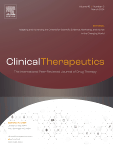
Publication date: Available online 14 November 2017
Source:Clinical Therapeutics
Author(s): Hae-Young Lee, Seok-Yeon Kim, Kee-Joon Choi, Byung-Su Yoo, Dong-Hun Cha, Hae Ok Jung, Dong-Ryeol Ryu, Joon Hyouk Choi, Kwang Je Lee, Tae Ho Park, Ju Hyeon Oh, Sang Min Kim, Ji-Yong Choi, Kye Hun Kim, Jaemin Shim, Woo-Shik Kim, Si-Wan Choi, Dae-Gyun Park, Pil-Sang Song, Taek-Jong Hong, Moo-Yong Rhee, Seung-Woon Rha, Seung Woo Park
PurposeThe objective of this study was to evaluate the efficacy and tolerability of a triple combination of amlodipine/losartan/rosuvastatin in patients with hypertension and hypercholesterolemia.MethodsA randomized, multicenter, double-blind, placebo-controlled study was conducted. Eligible patients with hypertension and a sitting diastolic blood pressure (SiDBP) of >90 mm Hg and LDL-C levels <250mg/dL were screened. After a 4-week run-in period with therapeutic lifestyle changes and losartan potassium 100mg once daily, patients who met both blood pressure criteria (80 mm Hg ≤ SiDBP < 110 mm Hg) and the LDL-C level criteria (defined in the National Cholesterol Education Program Adult Treatment Panel III cardiovascular risk categories) were randomized to 1 of 3 groups and treated once daily for 8 weeks: losartan potassium 100mg + rosuvastatin 20mg treatment (L/R 100/20) group, amlodipine camsylate 5mg + losartan potassium 100mg treatment (A/L 5/100) group, and amlodipine 5mg+ losartan potassium 100mg + rosuvastatin 20mg (A/L/R 5/100/20) group. The primary efficacy variables were the percent change in LDL-C in the A/L/R 5/100/20 and A/L 5/100 groups and the mean change of SiDBP in the A/L/R 5/100/20 and L/R 100/20 groups after 8 weeks of treatment, relative to baseline values.FindingsA total of 146 patients were enrolled and the demographic characteristics were similar among the 3 treatment groups. After 8 weeks of treatment, the mean (SD) percent change in LDL-C was significantly greater in the A/L/R group than in the A/L group (–48.40% [2.77%] vs –6.70% [3.00%]; P < 0.0001). Moreover, the mean change in SiDBP was significantly greater in the A/L/R group than in the L/R group (–9.75 [0.92] mm Hg vs –1.73 [1.03] mm Hg; P < 0.0001). SiDBP and LDL-C reductions in the A/L/R group were comparable to reductions in the A/L and L/R groups, respectively. Ten adverse events were reported in 7 patients (4.83%), and 1 patient from the A/L group (0.69%) experienced 2 adverse drug reactions (tachycardia and face edema), which were mild and resolved without specific treatment. There were no clinically significant tolerability issues during the treatment period.ImplicationsTriple combination therapy with amlodipine/losartan/rosuvastatin can be an effective therapeutic strategy in patients with hypertension combined with dyslipidemia. These findings will form the foundation of the future development of a single-pill triple combination. ClinicalTrials.gov identifier: NCT02899455.
http://ift.tt/2jFr1fE
